Key takeaways
- Mindfulness in education fosters emotional resilience, enhances focus, and nurtures empathy among students.
- Simple exercises, such as mindful breathing and sensory check-ins, can effectively shift classroom energy and promote presence.
- Creating a mindful classroom involves establishing a calm environment, modeling mindfulness, and developing shared agreements on respect and engagement.
- Challenges in teaching mindfulness can be addressed by acknowledging student discomfort and integrating brief practices into the curriculum without overwhelming it.
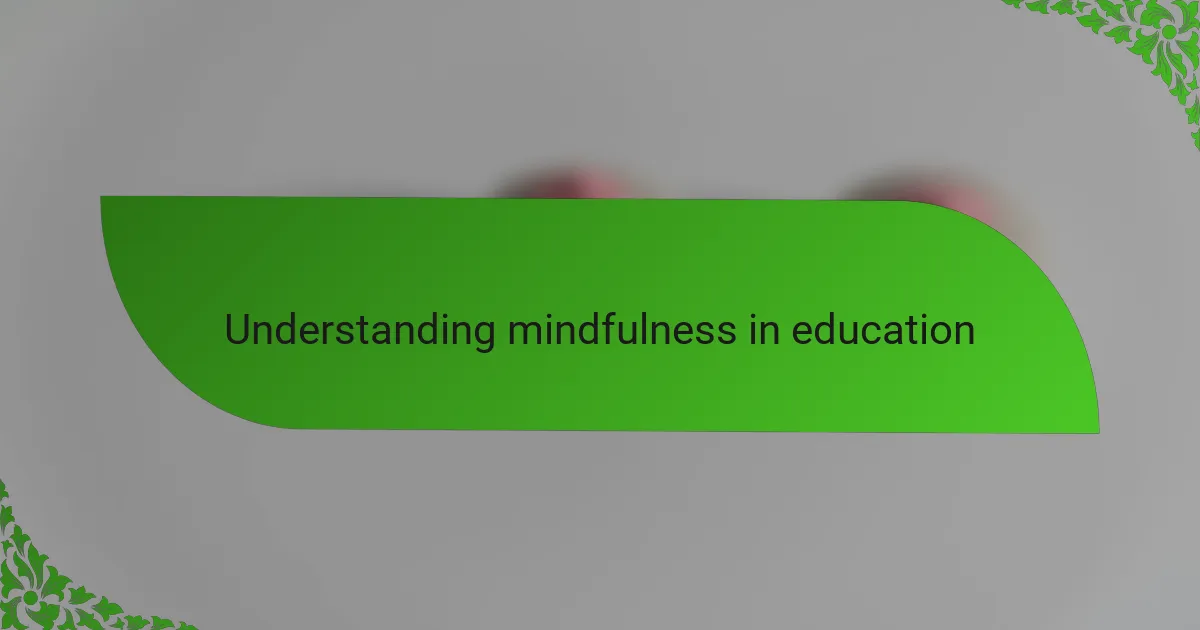
Understanding mindfulness in education
Mindfulness in education isn’t just about teaching kids to sit quietly; it’s about helping them truly experience the moment. I’ve noticed that when students pause to breathe and observe their thoughts, their natural curiosity surfaces. Have you ever wondered why some lessons stick while others fade away? I believe it’s because mindfulness creates a space for deeper connection.
From my experience, mindfulness fosters emotional resilience in students. When they learn to acknowledge feelings without judgment, they gain tools to navigate stress and distractions. It’s not always easy, though — sometimes students resist slowing down, but their gradual acceptance often amazes me.
Why does mindfulness matter in a classroom buzzing with activity? For me, it’s the bridge between chaos and calm, the moment where learning becomes more than information. It invites students to connect not only with the material but with themselves, strengthening both focus and empathy.
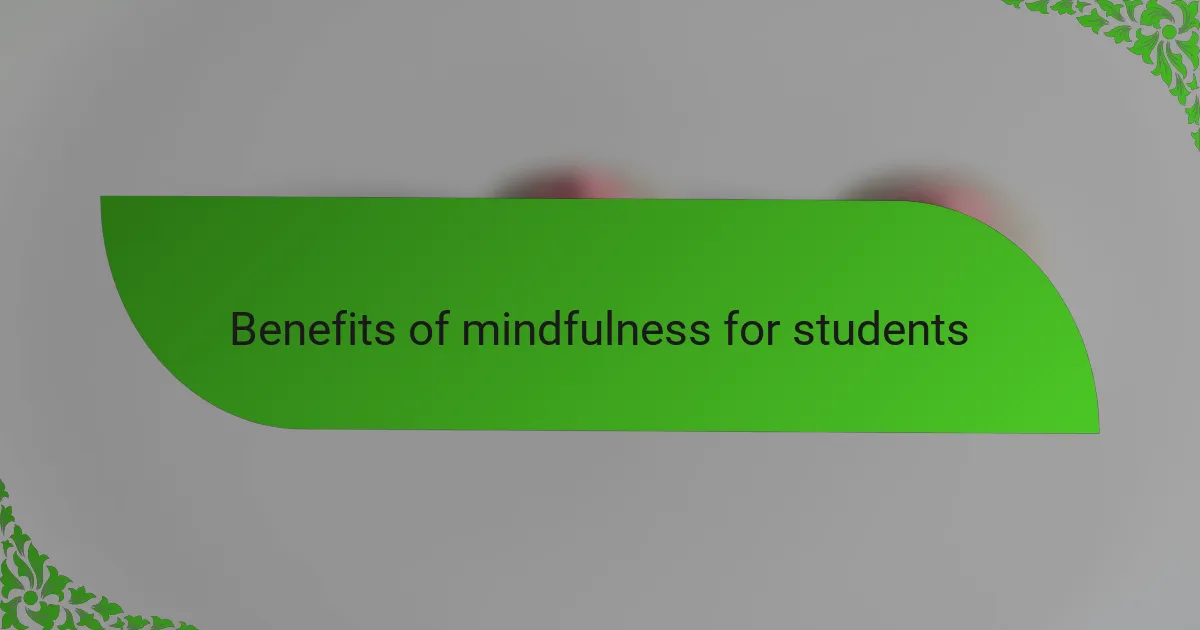
Benefits of mindfulness for students
When I first introduced mindfulness practices, I saw shy students start to open up and more energetic ones find an unexpected calm. Have you ever witnessed a student’s face soften after just a few deep breaths? It’s remarkable how such a simple pause can unlock focus and reduce anxiety, allowing them to dive into learning with clearer minds.
What truly stands out to me is how mindfulness boosts students’ emotional awareness. I remember a time when a usually distracted student shared how these moments helped him recognize frustration before it took over. That kind of self-awareness isn’t just helpful in class—it’s a lifelong skill that builds resilience.
Another benefit I’ve observed is how mindfulness nurtures empathy among students. When they slow down and reflect, they become more attuned to their own feelings and, surprisingly, to their peers’ struggles as well. This creates a kinder classroom atmosphere that supports collaboration and respect, which I find deeply rewarding as an educator.
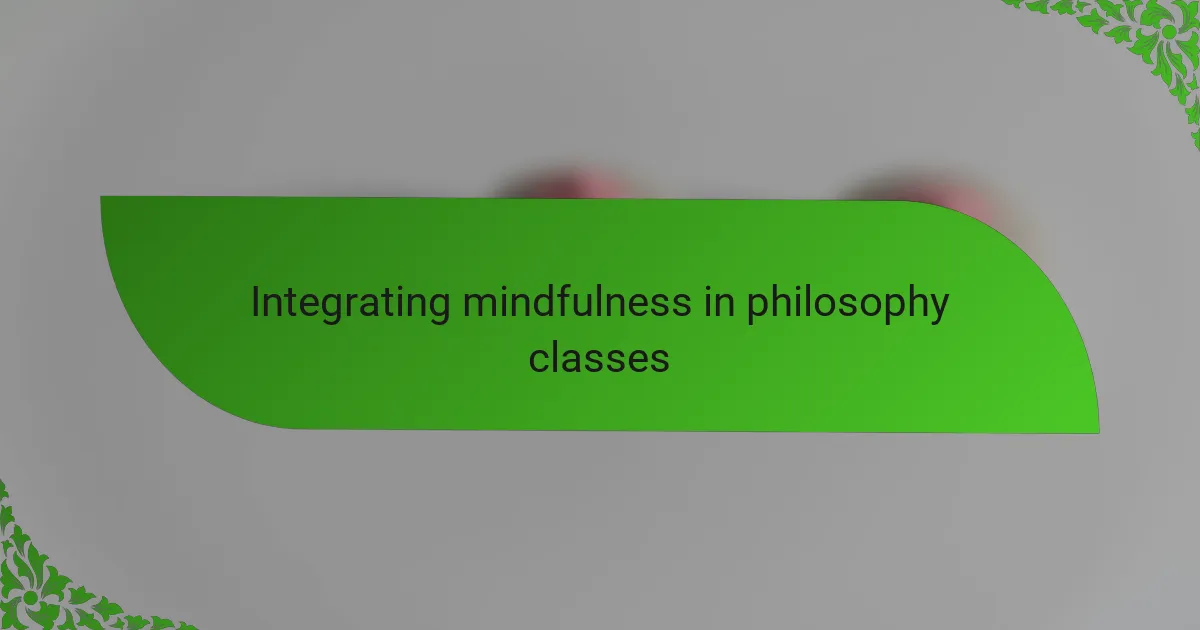
Integrating mindfulness in philosophy classes
Integrating mindfulness in philosophy classes has been an eye-opener for me. I often start discussions with a brief centering exercise—just a minute or two of mindful breathing—and I notice how it settles the room, sharpening students’ ability to grapple with complex ideas. Have you ever tried pausing before diving into a tough philosophical concept? That pause can open up space for true reflection rather than rushed reactions.
I’ve found that mindfulness deepens students’ engagement with abstract topics. When they learn to observe their thoughts nonjudgmentally, they start questioning assumptions in a more open, curious way. One student once told me that these moments helped her “hear” ideas she would’ve otherwise dismissed—proof that mindfulness isn’t just calming; it’s a tool for clearer thinking.
Sometimes I weave mindfulness into philosophy texts themselves, inviting students to reflect quietly on a paradox or ethical dilemma before sharing their views. This small ritual seems to foster patience and empathy, qualities essential not only for understanding philosophers but for navigating our own complex lives. Isn’t that what philosophy ultimately asks us to do—pause, ponder, and connect?
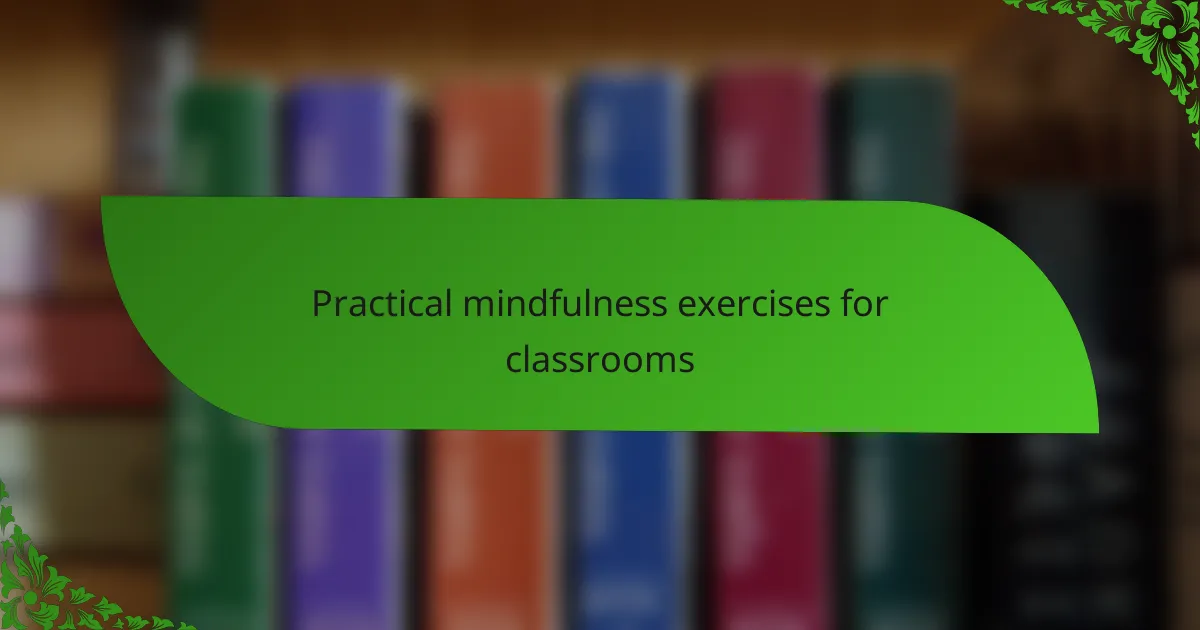
Practical mindfulness exercises for classrooms
One simple exercise I often use is a “mindful minute” at the start of class, where students close their eyes and focus solely on their breathing. It’s fascinating how this tiny pause can transform a noisy, distracted room into one of quiet anticipation. Have you noticed how just 60 seconds can shift energy and attention so dramatically?
Another approach I’ve found effective is the “sensory check-in,” where I ask students to name three things they can see, hear, or feel right at that moment. This grounding technique helps anchor their awareness in the present, especially when lessons get abstract or overwhelming. I’ve seen students visibly relax as they reconnect with their immediate experience — it’s like hitting the reset button on their minds.
Sometimes, I invite students to do a brief body scan, guiding them to notice tension or ease in different parts of their body. This practice often surprises them, revealing how unnoticed stress can hold their focus hostage. After these moments, I’ve watched classmates offer each other more patience and understanding, showing me firsthand how mindfulness can cultivate a gentler classroom culture.
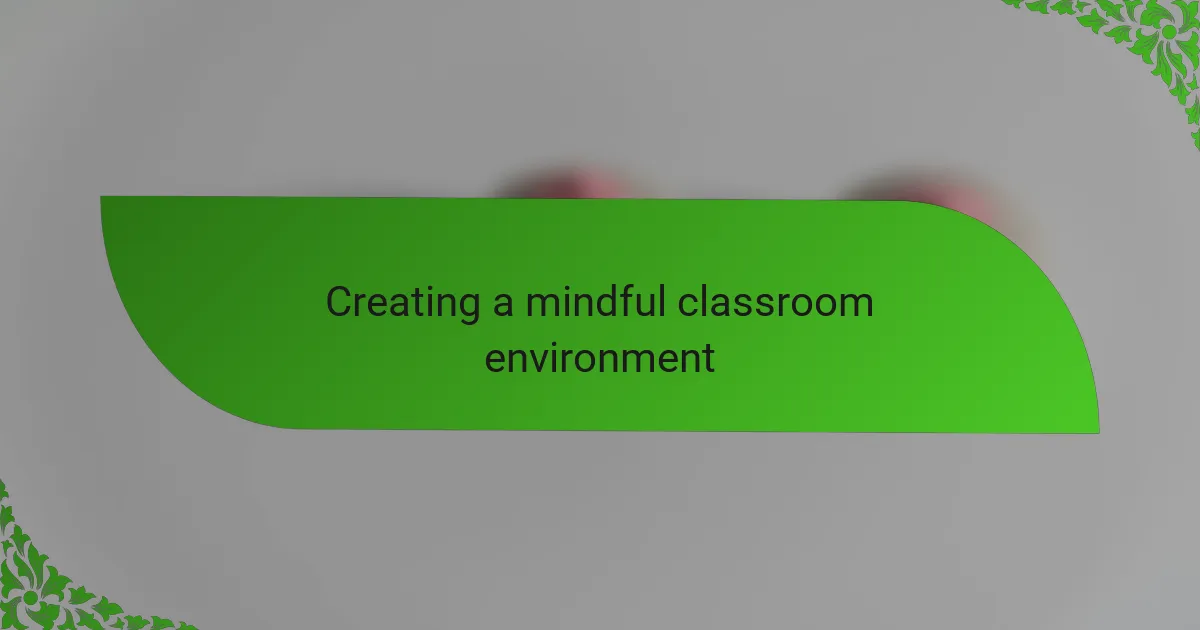
Creating a mindful classroom environment
Creating a mindful classroom environment starts with arranging the physical space in a way that feels calm and inviting. I like to keep the room uncluttered, with soft lighting and areas where students can sit comfortably for quiet reflection. Have you ever noticed how a well-organized space can almost silently encourage a more peaceful state of mind?
I also make it a point to model mindfulness through my own behavior—speaking slowly, listening attentively, and showing patience when things get hectic. In those moments, I can feel the atmosphere shift, as if the students pick up on the subtle cues and begin to mirror that calm. Sometimes I catch myself thinking, “If I can stay grounded, maybe they can too.”
Another key element I focus on is establishing shared agreements with the class about respect and presence. We talk openly about what it means to be fully engaged and kind to one another, which creates a sense of safety that’s essential for mindfulness to take root. I’ve seen firsthand how these conversations lay the groundwork for students to open up and truly be present together.
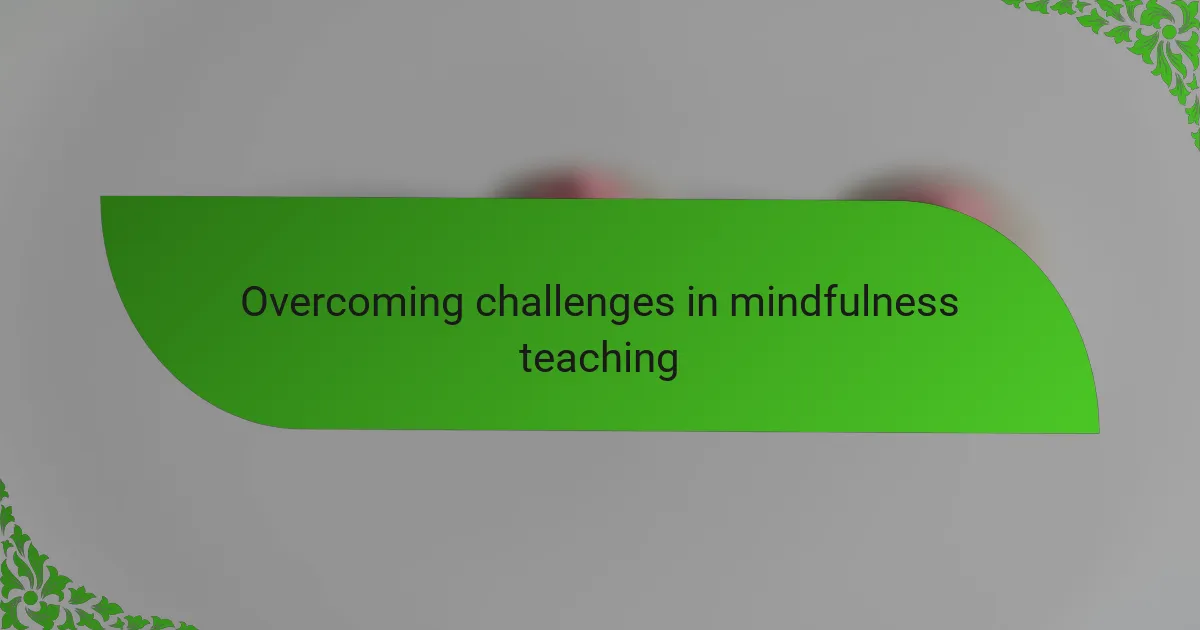
Overcoming challenges in mindfulness teaching
Challenges in teaching mindfulness often arise when students are restless or skeptical. I remember early on, some students would roll their eyes or fidget so much it was hard to keep their attention. But I found gently acknowledging their discomfort and inviting them to simply notice those feelings without judgment helped shift the dynamic gradually.
Another hurdle is balancing mindfulness practices with a packed curriculum. Have you ever felt the tension between wanting to slow down and the pressure to cover so much material? I’ve learned that even brief moments—like a one-minute breath check—can be powerful without taking away from lesson time, making mindfulness feel doable rather than overwhelming.
Sometimes, cultural differences influence how students respond to mindfulness exercises. I once had a class where some students were hesitant because this kind of practice felt unfamiliar or even strange to them. Creating a space where questions and doubts were welcomed opened the door for curiosity and allowed mindfulness to become a shared experience, rather than a prescribed routine.